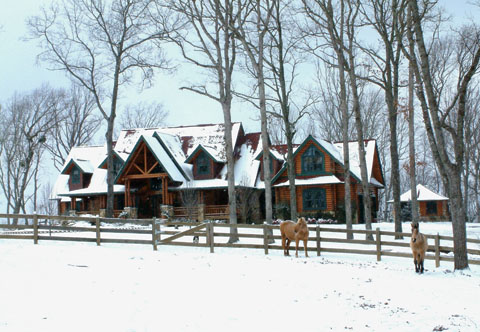With any home, maintenance plays an important role in protecting your investment from the elements and from the normal wear and tear that are inflicted on it on a daily basis. Ignore this important aspect of log home ownership and you could find yourself dealing with high repair and restoration bills, and a lot of heartache. Where log homes are different from traditional construction lies mainly in the logs themselves. While these natural wonders are strong, sturdy, and beautiful, they are also vulnerable, just like any other home. Wind, sun, and rain can take their toll on any home that hasn’t been properly maintained, cleaned, and inspected.
Where to Start
Keeping a log home in pristine condition starts with the home’s plan. By making good design choices (such as integrating gutters and downspouts into the plans), you can adequately protect your home from the elements. You’ll also want to consider adding components like roof overhangs and extended porches on the side of the abode that has the greatest exposure to the sun.
“There are a number of steps you can take to ensure your log home’s longevity, and to keep it in top shape,” says Jon Ozbun, owner of Western Log Home Restoration in North Bend, Washington. Some of those most important steps include cleaning your home regularly, developing a schedule for recoating the logs (see your manufacturer’s instructions and warranty guidelines for more information), and to regularly inspect for changes (such as new “bubbles”) on the home’s exterior and interior.
Expect to spend about $1,500 a year maintaining your log home, says Ozbun, citing a recent Log Homes Council study. That cost pales in comparison to the price of completely restoring a 2,000- to 3,000-square-foot structure that’s been neglected for years. “If you let it get to that point, you’ll wind up spending about $15,000 to blast it, restore it, and restain it. The owner who keeps up with the maintenance doesn’t have to worry about that big bill.”
Ozbun identifies some of the most important areas of a log home that should be inspected and/or maintained on a regular basis as:

Golden Eagle Log Homes
The log ends. “These are the most critical, and the most problematic, because they draw in 10 times more moisture than any other part of the log,” says Ozbun. “You’ll want to have them grinded down and restained every couple of years.”
Areas that are exposed to sunlight. The sun is the log home’s biggest enemy, particularly when it comes to preserving stains. “The sun breaks them down pretty quickly,” says Ozbun. Keep an eye on these vulnerable areas of your home, and re-stain regularly.
Areas that are exposed to rain and moisture. “If you have logs that lay on the roofline, and that are constantly getting wet, it can turn into a real problem,” says Ozbun. Again, pay attention to these areas, and use elements like downspouts and gutters to avert the rain and keep the logs dry.
Oil-based stains. Such stains require a new maintenance coat every two years, says Ozbun.
Regular log washing. Using a damp, soft-bristled brush, go over each log with the log-washing product your log home producer recommends to be sure all of the dirt and grime is removed during this process. “Then apply your maintenance coat of stain,” says Ozbun.
On the inside. The interior of your log home also needs regular attention. Using a product your log home producer recommends, you should go over the logs and surrounding areas twice a year at minimum. This task may be more difficult for homes whose logs aren’t clear-coated—a process that “makes them a lot easier to wash,” says Ozbun.
Finally, be sure to keep an eye out for rot. While hard to detect, rot can often be found by tapping the logs with a screwdriver and listening for any “hollow” sounds. “This is a particularly important for owners of older log homes,” says Charis Babcock, technical customer service manager for Denver-based Sashco, Inc., a manufacturer of log home maintenance and restoration products. “When detected early, it can be eradicated much faster, for a lot less money.”
Babcock says those log homeowners who get into a regular annual or semi-annual maintenance routine will be the ones who get the most enjoyment from their investments. “Natural logs are completely different animals than siding or concrete, and definitely require a bit more looking after,” says Babcock. “Keeping up with the maintenance will not only save you gobs of money over time, but also will ensure that your log home stays beautiful.”

